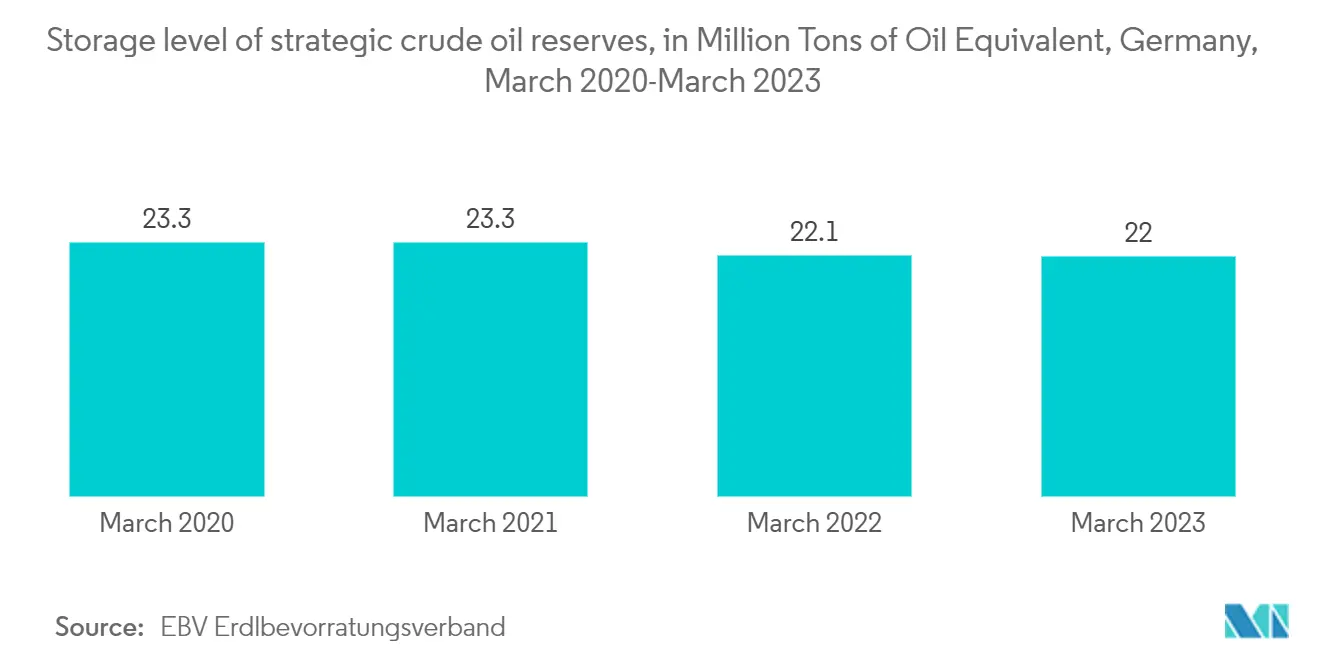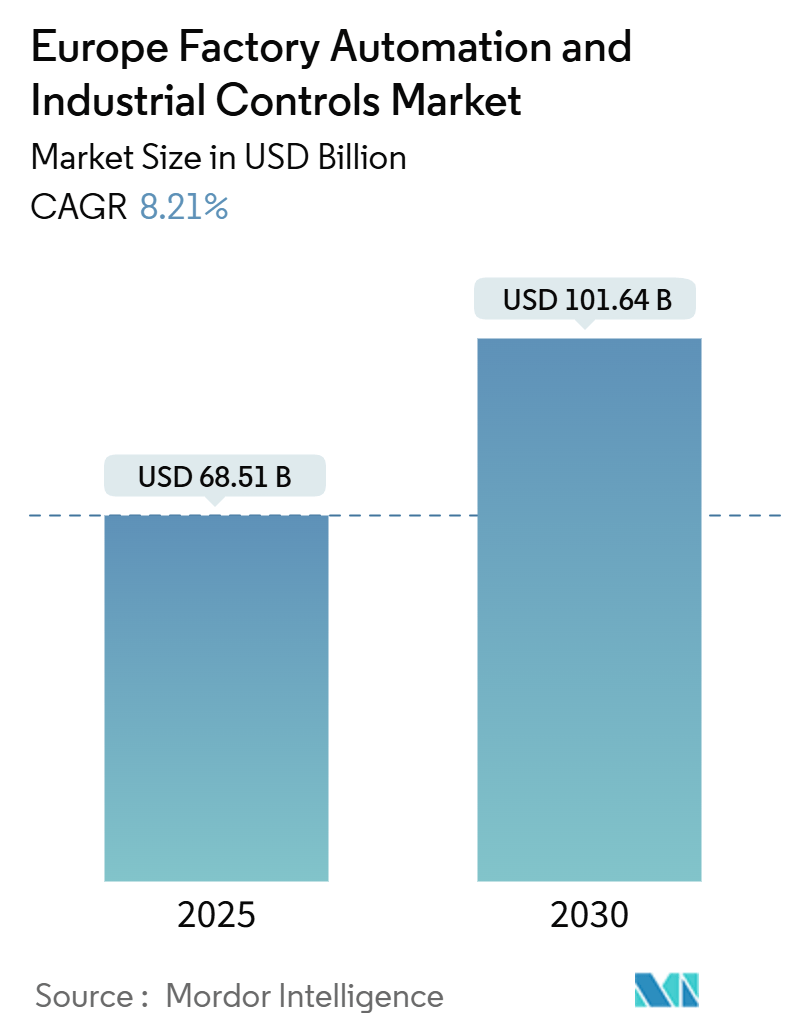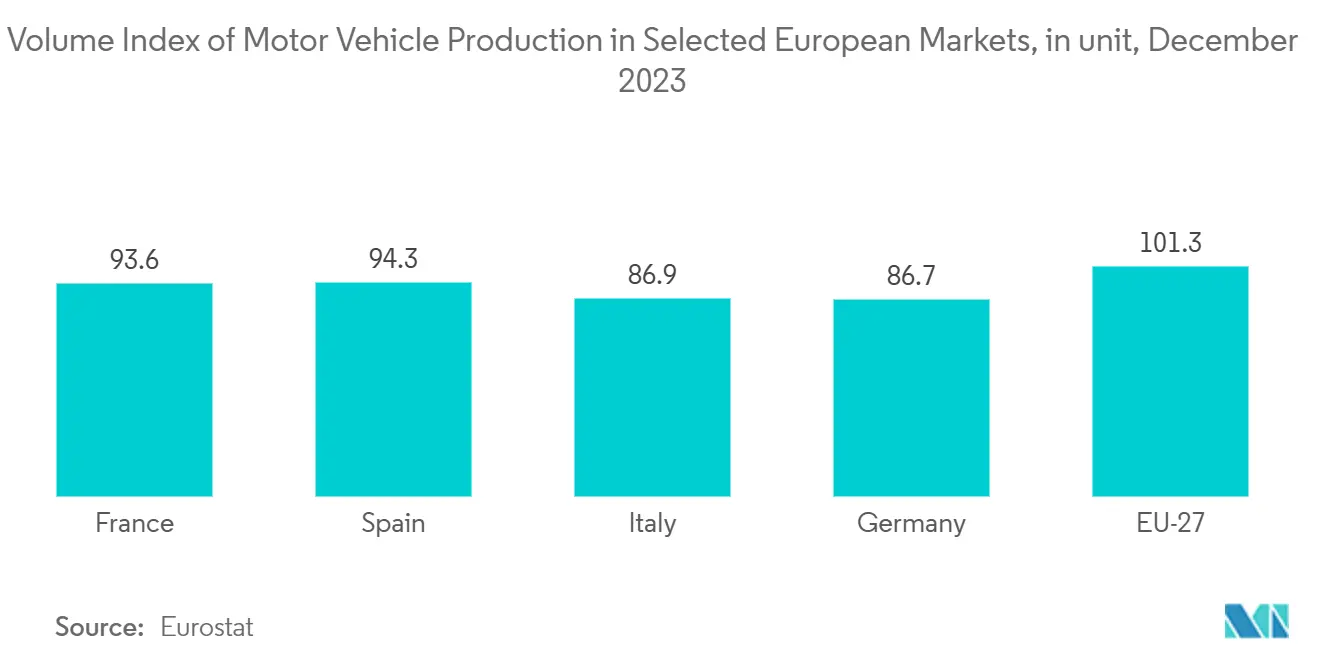| Study Period | 2019 - 2030 |
| Base Year For Estimation | 2024 |
| Forecast Data Period | 2025 - 2030 |
| Market Size (2025) | USD 68.51 Billion |
| Market Size (2030) | USD 101.64 Billion |
| CAGR (2025 - 2030) | 8.21 % |
| Market Concentration | Low |
Major Players*Disclaimer: Major Players sorted in no particular order |
Europe Factory Automation & Industrial Controls Market Analysis
The Europe Factory Automation And Industrial Controls Market size is estimated at USD 68.51 billion in 2025, and is expected to reach USD 101.64 billion by 2030, at a CAGR of 8.21% during the forecast period (2025-2030).
- Factory automation provides a compelling way to improve efficiency, quality, safety, sustainability, and security in a rapidly changing modern factory setting. Factory Automation & Industrial Control solutions cover the automation of an entire manufacturing facility via the design and construction of a fully integrated and intelligent control system, requiring sensors, instruments, computers, and data processing applications.
- With a rapid increase in competition and evolving end-user requirements, manufacturing units in the region are forced to adopt newer technological innovations and digital transformation solutions to make their business process as efficient as possible. For instance, field devices, like motors and sensors, offer opportunities to the auto industry to react faster to market requirements, reduce manufacturing downtimes, enhance supply chain efficiency, and expand productivity.
- The region is also adopting industrial automation in various industries, with significant firms launching industrial automation products in the market. For instance, Schneider Electric, a player in the digital transformation of energy management and automation, announced the ClimaSys smart ventilation system, an intelligent solution for filtering and managing the airflow for multiple control panels or electrical distribution cabinets in new or renovated applications. Moreover, sustainability in the manufacturing sector is expected to be a significant driver for the market studied.
- Multiple major key vendors operating in the region are launching new updates to help grow smart factories with developments in factory automation and industrial control systems. Such technological advancement indicates the region's growth in the studied market.
- The evolution of programmable logic controllers (PLCs) is expected to play a vital role in driving the industry's development into the digital era. With greater programming flexibility and convenience, scalability, more memory, smaller form factor, high-speed (Gigabit) Ethernet, and embedded wireless functionalities, future PLCs are poised to adapt technological improvements in software, communications, and hardware in the region.
- Post-pandemic had a notable impact on European industries. The industrial sector was forced to restructure the way it operated significantly due to multiple restrictions imposed by the government and fluctuation in demand during covid. For instance, some industries had to either shut down their operation temporarily or were forced to operate with limited availability of a human workforce.
- This sudden disruption, however, has significantly enhanced the awareness of the benefit of modern technologies such as automation, IIoT, and AI. As a result, various industries that earlier were reluctant to adopt these technologies, considering the high initial cost involved, are now open to increasing their investment. This shift in the mindset is expected to have a long-term impact on the growth of the studied market.
Europe Factory Automation & Industrial Controls Market Trends
Automotive Industry to Drive the Market Growth
- The automotive industry is among the vital sectors that hold a significant share of the world's automated manufacturing facilities. The production facilities of various automakers are automated to maintain efficiency. The growing trend of replacing conventional vehicles with EVs is expected to further augment the automotive industry's demand.
- The primary concern of the automotive industry is the length of a project. Hence, quick return-on-investment projects, combined with low-cost automation and cost innovation, are helping manufacturers improve competitiveness through productivity improvement. The growing adoption of automation in manufacturing processes and digitization and AI involvement are primary factors driving industrial robot demand in the automotive sector.
- France and Germany, below the European average volume index in March 2022 and December 2023, were the markets with the highest turnover from motor vehicle and trailer manufacturing in the European Union. According to UBS, Europe's projected electric vehicle sales are expected to reach 6.33 million units by 2025, followed by China, with 4.84 million units. As Europe is leading the electric vehicles demand, the region is anticipated to see an increase in smart automotive factories' implementation.
- The growing presence of robots and automation in the European automotive industries is further expected to fuel the region's smart factory. Germany also possesses the largest concentration of automotive OEM plants in Europe. A further increase in OEM sites in the country is expected to increase industrial control systems' demand.
Germany to Witness Significant Growth
- Germany is not only a significant consumer of automation equipment but also a major manufacturer of automation equipment in Europe. Several significant automation and control equipment players, such as Siemens, Schneider Electric, KUKA, etc., are based out of Germany, thus driving a high investment flow toward R & D activities.
- The country has been witnessing rapid growth in the demand for automation solutions. Enterprises in Germany are beginning to reimagine automation by looking more closely at the processes to be automated and whether they are delivering the expected outcomes. This next-gen automation is catching on with a few large companies and has strong growth potential in the next few years. As of the end of March 2023, Germany had 22 million tons of oil equivalent in strategic crude oil reserves. This was basically unchanged compared to the same time a year before.
- According to recent estimates from the International Federation of Robotics (IFR), Germany has the third most robot density in the world (338 units per 10,000 workers) after Singapore and South Korea. IFR estimates that several installed robots in Germany have grown by 6% to 23,777 units lately due to the increasing demand for robots in various industries, focusing on the automotive industry. This rising supply of industrial robots in the country is expected to drive the market studied.
- The development of a complete 5G ecosystem in the country will further accelerate the pace of digitization in the industry. This factor will strengthen Germany’s position in global competition. Deutsche Telekom, a German telecommunications company, recently added new partners for its 5G-based smart factory ecosystem. The new partners are EK Automation, Konica Minolta, and Endress+Hauser.

Europe Factory Automation & Industrial Controls Industry Overview
The Europe Factory Automation and Industrial Controls Market is highly competitive and consists of various major players. The presence of key players has further strengthened its capability to develop highly established products, with the ability to transform the industrial application of technology. With the increasing importance on performance and rising levels of competition in the industry, the market is poised to witness strong growth over and beyond the forecast period. Key players in the market are Schneider Electric SE, Rockwell Automation Inc., Honeywell International Inc., Emerson Electric Company, ABB Ltd, Mitsubishi Electric Corporation, Siemens AG, and many more.
The Europe factory automation and industrial controls market is set for robust growth, driven by technological advancements and increasing demand from key industries such as automotive, increasing automation in manufacturing processes, and the rising demand for efficient production solutions across various industries.
Europe Factory Automation & Industrial Controls Market Leaders
-
Rockwell Automation Inc.
-
Schneider Electric SE
-
Siemens AG
-
ABB Ltd
-
Honeywell International Inc.
- *Disclaimer: Major Players sorted in no particular order

Europe Factory Automation & Industrial Controls Market News
- June 2024: ABB announced to invest USD 35 million in new U.K. earthing and lightning protection factory. The new state-of-the-art site is expected to open in early 2025 and will integrate advanced technology, flexible automation, R&D and testing, and digital processes to boost production capacity and enhance efficiency and sustainability.
- February 2024: OTee, an Oslo-based developer of industrial automation software, has raised EUR 1.25 million (USD 1.31 million) in its latest funding round. OTee provides an engineering platform for designing, deploying, and managing virtual control systems based on open architecture and standards. Essentially, the company has the potential to enable cheaper, faster, more sustainable, and more secure industrial control systems automation.
Europe Factory Automation & Industrial Controls Industry Segmentation
The factory automation and control solutions facilitate the automation of a production facility/entire manufacturing by constructing and designing a wholly intelligent and integrated control system, including robots, sensors, computers, industrial instruments, and advanced data processing solutions.
The Europe Factory Automation and Industrial Controls Market is segmented by type (industrial control systems, field devices), by end-user industry (automotive, chemical and petrochemical, power and utility, pharmaceutical, food and beverages, oil and gas), and by country. The market sizes and forecasts are provided in terms of value (USD) for all the above segments.
| By Product | Industrial Control Systems | Distributed Control System (DCS) | |
| Programmable Logic Controller (PLC ) | |||
| Supervisory Control and Data Acquisition (SCADA) | |||
| Product Lifecycle Management (PLM) | |||
| Human Machine Interface (HMI) | |||
| Manufacturing Execution System (MES) | |||
| Enterprise Resource Planning (ERP) | |||
| Other Industrial Control Systems | |||
| Field Devices | Machine Vision Systems | ||
| Robotics (Industrial) | |||
| Sensors and Transmitters | |||
| Motors and Drives | |||
| Other Field Devices | |||
| By End-user Industry | Automotive | ||
| Chemical and Petrochemical | |||
| Power and Utility | |||
| Pharmaceutical | |||
| Food and Beverage | |||
| Oil and Gas | |||
| Other End-user Industries | |||
| By Country | United Kingdom | ||
| Germany | |||
| France | |||
| Spain | |||
| Rest of Europe | |||
Europe Factory Automation And Industrial Controls Market Research Faqs
How big is the Europe Factory Automation And Industrial Controls Market?
The Europe Factory Automation And Industrial Controls Market size is expected to reach USD 68.51 billion in 2025 and grow at a CAGR of 8.21% to reach USD 101.64 billion by 2030.
What is the current Europe Factory Automation And Industrial Controls Market size?
In 2025, the Europe Factory Automation And Industrial Controls Market size is expected to reach USD 68.51 billion.
Who are the key players in Europe Factory Automation And Industrial Controls Market?
Rockwell Automation Inc., Schneider Electric SE, Siemens AG, ABB Ltd and Honeywell International Inc. are the major companies operating in the Europe Factory Automation And Industrial Controls Market.
What years does this Europe Factory Automation And Industrial Controls Market cover, and what was the market size in 2024?
In 2024, the Europe Factory Automation And Industrial Controls Market size was estimated at USD 62.89 billion. The report covers the Europe Factory Automation And Industrial Controls Market historical market size for years: 2019, 2020, 2021, 2022, 2023 and 2024. The report also forecasts the Europe Factory Automation And Industrial Controls Market size for years: 2025, 2026, 2027, 2028, 2029 and 2030.
Our Best Selling Reports
Europe Factory Automation And Industrial Controls Industry Report
Statistics for the 2025 Europe Factory Automation And Industrial Controls market share, size and revenue growth rate, created by Mordor Intelligence™ Industry Reports. Europe Factory Automation And Industrial Controls analysis includes a market forecast outlook for 2025 to 2030 and historical overview. Get a sample of this industry analysis as a free report PDF download.







